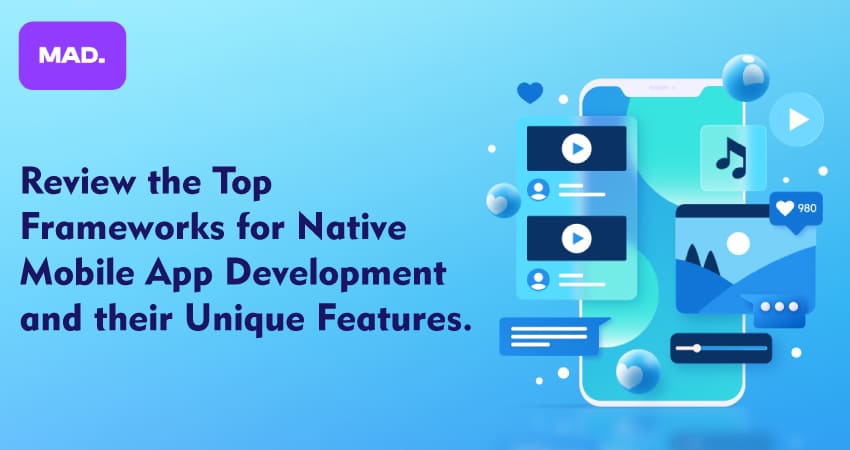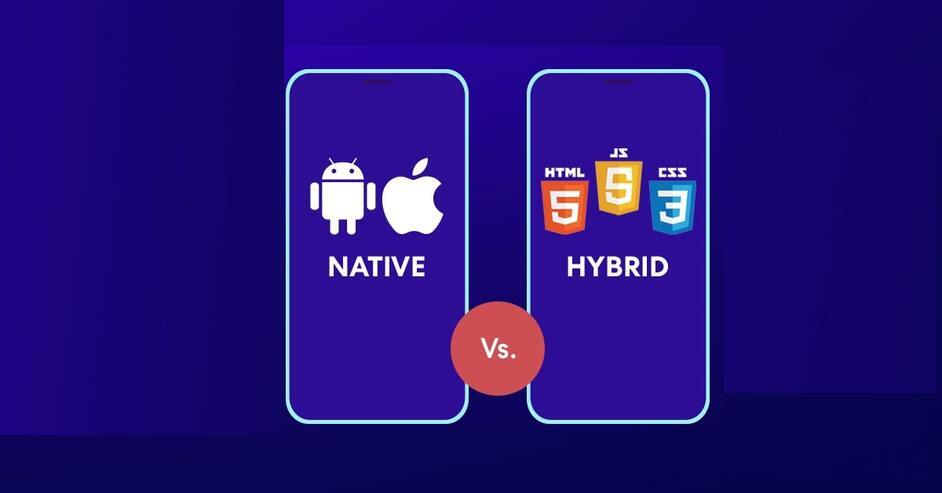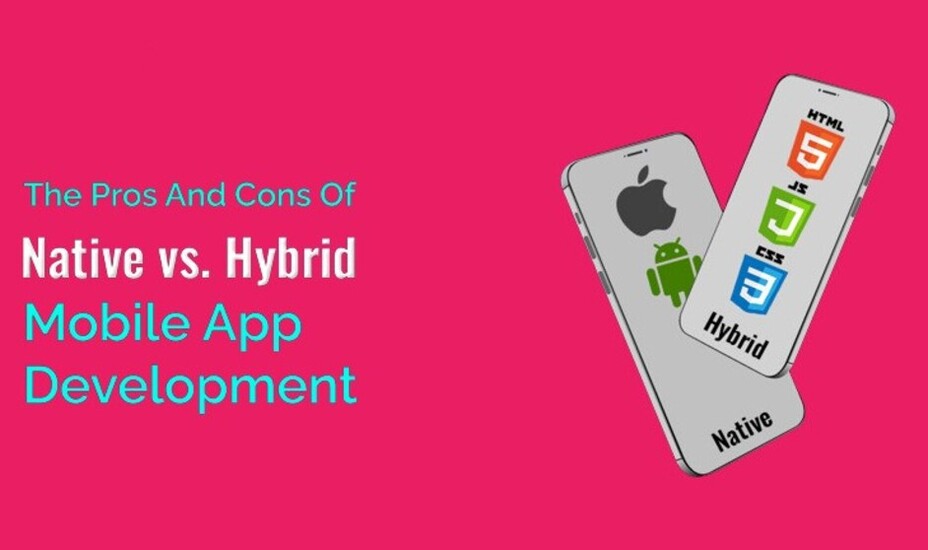New Jersey, USA
-
Location
-
Phone








Review the top frameworks for native mobile app development and their unique features

The world of mobile app development is constantly evolving, with an increasing focus on providing a seamless and efficient user experience. For developers, choosing the right framework for native mobile app development is crucial. Native frameworks offer optimized performance, better user experience, and access to the full feature set of the underlying operating system. In this blog post, we will delve into the top frameworks for native mobile app development, highlighting their unique features and capabilities to help developers make an informed choice. Whether you’re a seasoned developer or just starting out, understanding these frameworks will enhance your ability to create outstanding mobile applications.
“The blog explores the top frameworks for native mobile app development, focusing on React Native and Flutter. React Native, developed by Facebook, allows developers to use a single codebase for both iOS and Android, enhancing development efficiency with features like live and hot reloading. Flutter, by Google, offers a widget-centric approach and compiles to native ARM code, ensuring high performance and providing extensive widgets for streamlined UI/UX design. Both frameworks support cross-platform development, but differ in execution and community support. Choosing the right framework depends on project needs, performance requirements, and developer skill sets, impacting overall app success.”
Top Frameworks for Native Mobile App Development

The landscape of native mobile app development is rich with frameworks designed to empower developers to create dynamic, efficient, and powerful applications tailored for the specific platforms they aim to serve. Each framework offers a unique set of tools, libraries, and functionalities making the building process more refined and innovative. Here, we delve deep into the unique attributes of two preeminent frameworks that have been shaping the world of mobile app development significantly.
Framework 1: React Native - Unique Features
React Native, crafted by the engineers at Facebook, revolutionizes mobile app development by blending the best parts of native development with React, a best-in-class JavaScript library for building user interfaces. Some unique features that make React Native a standout choice include:
- Learn Once, Write Anywhere: React Native applies the same design as React, letting you compose a rich mobile UI from declarative components. With React Native, you can use the same codebase for both iOS and Android platforms, which not only speeds up the development process but also maintains consistency across platforms.
- Live Reloading and Hot Reloading: This feature enhances a developer's efficiency significantly. Live Reloading refreshes the entire app when a file changes, whereas Hot Reloading only reloads the file that was changed without losing the state of the app. This is particularly useful in tweaking the UI, where small visual adjustments can be seen instantaneously.
- Native Components: React Native uses native components controlled by JavaScript. This means that the app will use the same native platform APIs other apps do. Therefore, unlike hybrid apps, apps developed with React Native perform as well as native apps written in Swift or Java.
- Thriving Ecosystem and Community Support: Being an open-source framework, React Native enjoys robust community support. Developers have access to a plethora of libraries and tools that are being constantly improved and expanded.
- Backward Compatibility: React Native is very flexible with updates and versions. It ensures that newer versions of the framework are compatible with older projects, reducing the worry of potential breaks or changes in older apps when updating the framework.
Flutter - Unique Features
Flutter, developed by Google, has swiftly risen to popularity as a powerful contender in the native mobile app development arena. It is known for creating high-quality native interfaces on iOS and Android in record time. Here are some of its unique features:
- Everything is a Widget: Flutter's core design philosophy is that everything seen on the app interface is a widget. Widgets describe what their view should look like given their current configuration and state. This widget-centric approach makes it much easier to build complex UIs since the entire layout and its elements are treated as widgets.
- Single Codebase for All Platforms: Like React Native, Flutter also supports cross-platform code sharing. However, Flutter not only targets mobile platforms but extends support to web and desktop applications as well, all from a single codebase.
- Rich Motion APIs: Flutter comes with a rich set of motion APIs that allow developers to include intricate and custom animations in their app, making it interactive and visually appealing without a lot of heavy lifting.
- Hot Reload: Much like React Native's hot reloading, Flutter's hot reload feature helps you quickly and easily experiment, build UIs, add features, and fix bugs. Hot reload works by injecting updated source code files into the running Dart Virtual Machine (VM). After the VM updates classes with the new versions of fields and functions, the Flutter framework automatically rebuilds the widget tree, allowing you to quickly view the effects of your changes.
- Extensive Catalog of Ready-to-Use Widgets: Flutter provides a broad spectrum of styled and tested widgets that follow Apple’s iOS design (Cupertino) and Google’s material design guidelines. These widgets are optimized for mobile environments, ensuring that they perform excellently on both iOS and Android platforms.
Comparison of the Frameworks
When selecting a framework for native mobile app development, several factors come into play. Key among these are the speed of development, overall performance, and community support. By comparing these attributes, developers can make informed decisions tailored to their specific needs.
Speed of Development
React Native and Flutter both significantly reduce the development time compared to native development frameworks such as Swift and Kotlin due to their cross-platform nature. However, Flutter tends to edge React Native slightly in this aspect due to its extensive range of widgets and tools that simplify the UI/UX process, reducing the time from concept to deployment. React Native, meanwhile, benefits from the vast amount of ready-to-use React components and the ability to integrate with existing code, which can accelerate development cycles for projects expanding on existing apps.Performance
Performance is paramount in mobile app development. React Native interacts with the native components through a bridge which can lead to performance bottlenecks, especially in complex animations or when handling large datasets. Flutter, on the other hand, compiles to native ARM code to avoid performance issues associated with the bridge, providing a smoother performance closer to that of native applications. Therefore, for applications where performance is a critical determiner, Flutter might be the preferable option.Community Support
Both React Native and Flutter benefit from strong community support due to backing by industry giants (Facebook for React Native and Google for Flutter). They both have thriving ecosystems that are continuously evolving with frequent updates, debugging tools, and third-party plugins that extend functionality. However, React Native has been around longer and hence has a slightly larger community and more resources available for troubleshooting and learning. In contrast, Flutter, while newer, has seen rapid growth in community engagement and resource availability, which suggests promising support for the future.Choosing the Best Framework for Your Needs

Selecting the ideal framework for developing a native mobile app is a pivotally important decision that can greatly influence both the performance and success of the application. The choice often hinges upon various factors, including project requirements, developer proficiency, and the intended target audience’s platform (iOS, Android, or both). Here, we explore several aspects to consider when deciding which framework will best suit your development needs.
Project Requirements
The first and possibly most crucial consideration is understanding the specific requirements of your project. Different frameworks offer different capabilities and might serve various types of applications better than others. For example:
- If your app requires a lot of device-specific features and high performance, Swift for iOS and Kotlin for Android are preferable for their close-to-the-metal programming, which ensures maximum performance.
- For applications that demand shorter development cycles, something like React Native or Flutter could be more advantageous as they allow cross-platform development, which significantly reduces development time.
Consider the complexity of the UI/UX designs, the necessity for offline capabilities, scalability, and future maintenance when choosing the appropriate framework.
Developer Skill Set
The proficiency and experience of your development team can also guide your choice of framework. Native development for iOS and Android requires knowledge of Swift and Kotlin/Java, respectively, which can pose a steep learning curve for developers accustomed to web development technologies.
Cross-platform frameworks like React Native or Flutter allow developers to use a single codebase to deploy on both iOS and Android and might be more suitable for teams more familiar with JavaScript or Dart. Assessing the available expertise can help mitigate steep learning curves and streamline the development process.
Performance Considerations
Performance is often the key metric that ultimately influences the framework choice, especially for graphically intensive applications like games or heavily interactive apps. Native development typically offers the best performance since it is optimized for the specific platform:
- Swift and Kotlin are designed to leverage the full capabilities of the underlying platform, offering seamless integration with device hardware.
- React Native and Flutter, while still offering high performance, might face limitations with rendering complex animations or when managing heavy computational tasks compared to their native counterparts.
It’s important to analyze the performance demands of your app in detail and choose accordingly.
Cost Implications
The total cost of development can vary significantly between different frameworks. Native development might require separate iOS and Android teams, which doubles the human resource needs:
- Developing natively for iOS and Android tends to be more resource-intensive and can increase the project costs, especially if hiring specialists in both Swift and Kotlin.
- Cross-platform solutions like React Native or Flutter can reduce these costs by allowing a single team to work across both platforms.
Consider the long-term costs too, including maintenance and updates. Sometimes the initial cheaper option might end up more costly in the long run.
Long-Term Maintenance and Scalability
Maintaining and scaling an app is an ongoing challenge that requires forward-thinking during the framework selection process. Native apps generally have a higher longevity in terms of performance optimization and alignment with the latest technological advancements provided by iOS and Android updates.
Cross-platform frameworks provide quicker updates across all platforms, which can be beneficial for applications that do not heavily rely on new platform-specific features. Here, the choice depends greatly on how frequently you expect to update your application and whether the updates rely more on content or functionality.
Community Support and Resources
The strength and activity of a framework’s developer community can significantly impact your project. A strong community means better support, more frequent updates, and a larger pool of accessible resources like plugins and third-party libraries, which can accelerate development:
- Swift and Kotlin benefit from robust support by Apple and Google respectively, along with a vast ecosystem of developers.
- React Native boasts a large community and a wealth of libraries and tools that facilitate mobile app development.
- Reviewing community engagement and available resources can provide significant insight into how easy it will be to implement specific features and maintain your app.
Choosing the right framework for your native mobile app development project is a decision that should not be taken lightly. By considering your project’s specific needs, your team’s skill set, performance requirements, cost implications, long-term maintenance, and the available community resources, you can select a framework that not just meets but exceeds your expectations, ultimately ensuring the success of your project. Whether you lean towards the straightforward, robust approach of native development or the versatile, cost-effective strategy of cross-platform frameworks, the right choice is out there waiting to be discovered.
Conclusion
In the realm of mobile app development, the choice of the right framework is pivotal. Each of the frameworks discussed offers unique benefits tailored to various development needs. Whether you value speed and efficiency, a vast support community, or extensive customization features, there's a framework designed to meet those specifications. Assessing your project requirements and matching them with the right features of a framework can significantly influence the success of your mobile application. Always consider the long-term impact of your choice, as it not only affects the development process but also the ongoing maintenance and scalability of your app. Choosing wisely will provide a sturdy foundation for your app’s future.
MAD is a top app development company in the USA, a high-performance low-code platform that enables rapid and easy mobile app development compared to traditional coding methods.


